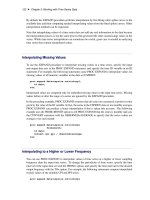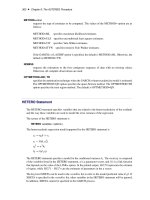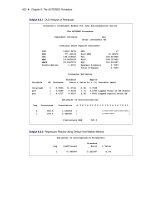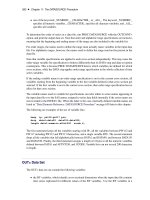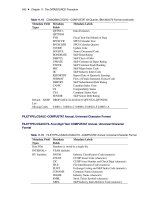SAS/ETS 9.22 User''''s Guide 50 potx
Bạn đang xem bản rút gọn của tài liệu. Xem và tải ngay bản đầy đủ của tài liệu tại đây (178.23 KB, 10 trang )
482 ✦ Chapter 9: The COMPUTAB Procedure
Details: COMPUTAB Procedure
Program Flow Example
This example shows how the COMPUTAB procedure processes observations in the program working
storage and the COMPUTAB data table (CDT).
Assume you have three years of figures for sales and cost of goods sold (CGS), and you want to
determine total sales and cost of goods sold and calculate gross profit and the profit margin.
data example;
input year sales cgs;
datalines;
1988 83 52
1989 106 85
1990 120 114
;
proc computab data=example;
columns c88 c89 c90 total;
rows sales cgs gprofit pctmarg;
/
*
calculate gross profit
*
/
gprofit = sales - cgs;
/
*
select a column
*
/
c88 = year = 1988;
c89 = year = 1989;
c90 = year = 1990;
/
*
calculate row totals for sales
*
/
/
*
and cost of goods sold
*
/
col: total = c88 + c89 + c90;
/
*
calculate profit margin
*
/
row: pctmarg = gprofit / cgs
*
100;
run;
Table 9.3 shows the CDT before any observation is read in. All the columns and rows are defined
with the values initialized to 0.
Program Flow Example ✦ 483
Table 9.3 CDT before Any Input
C88 C89 C90 TOTAL
SALES 0 0 0 0
CGS 0 0 0 0
GPROFIT 0 0 0 0
PCTMARG 0 0 0 0
When the first input is read in (year=1988, sales=83, and cgs=52), the input block puts the values for
SALES and CGS in the C88 column since year=1988. Also the value for the gross profit for that
year (GPROFIT) is calculated as indicated in the following statements:
gprofit = sales-cgs;
c88 = year = 1988;
c89 = year = 1989;
c90 = year = 1990;
Table 9.4 shows the CDT after the first observation is input.
Table 9.4 CDT after First Observation Input (C88=1)
C88 C89 C90 TOTAL
SALES 83 0 0 0
CGS 52 0 0 0
GPROFIT 31 0 0 0
PCTMARG 0 0 0 0
Similarly, the second observation (year=1989, sales=106, cgs=85) is put in the second column, and
the GPROFIT is calculated to be 21. The third observation (year=1990, sales=120, cgs=114) is put
in the third column, and the GPROFIT is calculated to be 6. Table 9.5 shows the CDT after all
observations are input.
Table 9.5 CDT after All Observations Input
C88 C89 C90 TOTAL
SALES 83 106 120 0
CGS 52 85 114 0
GPROFIT 31 21 6 0
PCTMARG 0 0 0 0
After the input block is executed for each observation in the input data set, the first row or column
block is processed. In this case, the column block is
484 ✦ Chapter 9: The COMPUTAB Procedure
col: total = c88 + c89 + c90;
The column block executes for each row, calculating the TOTAL column for each row. Table 9.6
shows the CDT after the column block has executed for the first row (total=83 + 106 + 120). The
total sales for the three years is 309.
Table 9.6 CDT after Column Block Executed for First Row
C88 C89 C90 TOTAL
SALES 83 106 120 309
CGS 52 85 114 0
GPROFIT 31 21 6 0
PCTMARG 0 0 0 0
Table 9.7 shows the CDT after the column block has executed for all rows and the values for total
cost of goods sold and total gross profit have been calculated.
Table 9.7 CDT after Column Block Executed for All Rows
C88 C89 C90 TOTAL
SALES 83 106 120 309
CGS 52 85 114 251
GPROFIT 31 21 6 58
PCTMARG 0 0 0 0
After the column block has been executed for all rows, the next block is processed. The row block is
row: pctmarg = gprofit / cgs
*
100;
The row block executes for each column, calculating the PCTMARG for each year and the total
(TOTAL column) for three years. Table 9.8 shows the CDT after the row block has executed for all
columns.
Table 9.8 CDT after Row Block Executed for All Columns
C88 C89 C90 TOTAL
SALES 83 106 120 309
CGS 52 85 114 251
GPROFIT 31 21 6 58
PCTMARG 59.62 24.71 5.26 23.11
Order of Calculations ✦ 485
Order of Calculations
The COMPUTAB procedure provides alternative programming methods for performing most calcu-
lations. New column and row values are formed by adding values from the input data set, directly or
with modification, into existing columns or rows. New columns can be formed in the input block or
in column blocks. New rows can be formed in the input block or in row blocks.
This example illustrates the different ways to collect totals. Table 9.9 is the total sales report for two
products, SALES1 and SALES2, during the years 1988–1990. The values for SALES1 and SALES2
in columns C88, C89, and C90 come from the input data set.
Table 9.9 Total Sales Report
C88 C89 C90 SALESTOT
SALES1 15 45 80 140
SALES2 30 40 50 120
YRTOT 45 85 130 260
The new column SALESTOT, which is the total sales for each product over three years, can be
computed in several different ways:
in the input block by selecting SALESTOT for each observation:
salestot = 1;
in a column block:
coltot: salestot = c88 + c89 + c90;
In a similar fashion, the new row YRTOT, which is the total sales for each year, can be formed as
follows:
in the input block:
yrtot = sales1 + sales2;
in a row block:
rowtot: yrtot = sales1 + sales2;
486 ✦ Chapter 9: The COMPUTAB Procedure
Performing some calculations in PROC COMPUTAB in different orders can yield different results,
because many operations are not commutative. Be sure to perform calculations in the proper sequence.
It might take several column and row blocks to produce the desired report values.
Notice that in the previous example, the grand total for all rows and columns is 260 and is the same
whether it is calculated from row subtotals or column subtotals. It makes no difference in this case
whether you compute the row block or the column block first.
However, consider the following example where a new column and a new row are formed:
Table 9.10 Report Sensitive to Order of Calculations
STORE1 STORE2 STORE3 MAX
PRODUCT1 12 13 27 27
PRODUCT2 11 15 14 15
TOTAL 23 28 41 ?
The new column MAX contains the maximum value in each row, and the new row TOTAL contains
the column totals. MAX is calculated in a column block:
col: max = max(store1,store2,store3);
TOTAL is calculated in a row block:
row: total = product1 + product2;
Notice that either of two values, 41 or 42, is possible for the element in column MAX and row
TOTAL. If the row block is first, the value is the maximum of the column totals (41). If the column
block is first, the value is the sum of the MAX values (42). Whether to compute a column block
before a row block can be a critical decision.
Column Selection
The following discussion assumes that the NOTRANS option has not been specified. When NO-
TRANS is specified, this section applies to rows rather than columns.
If a COLUMNS statement appears in PROC COMPUTAB, a target column must be selected for
the incoming observation. If there is no COLUMNS statement, a new column is added for each
observation. When a COLUMNS statement is present and the selection criteria fail to designate a
column, the current observation is ignored. Faulty column selection can result in columns or entire
tables of 0s (or missing values if the INITMISS option is specified).
During execution of the input block, when an observation is read, its values are copied into row
variables in the program data vector (PDV).
Controlling Execution within Row and Column Blocks ✦ 487
To select columns, use either the column variable names themselves or the special variable _COL_.
Use the column names by setting a column variable equal to some nonzero value. The example
in the section “Getting Started: COMPUTAB Procedure” on page 464 uses the logical expression
COMPDIV= value, and the result is assigned to the corresponding column variable.
a = compdiv = 'A';
b = compdiv = 'B';
c = compdiv = 'C';
IF statements can also be used to select columns. The following statements are equivalent to the
preceding example:
if compdiv = 'A' then a = 1;
else if compdiv = 'B' then b = 1;
else if compdiv = 'C' then c = 1;
At the end of the input block for each observation, PROC COMPUTAB multiplies numeric input
values by any nonzero selector values and adds the result to selected columns. Character values
simply overwrite the contents already in the table. If more than one column is selected, the values
are added to each of the selected columns.
Use the _COL_ variable to select a column by assigning the column number to it. The COMPUTAB
procedure automatically initializes column variables and sets the _COL_ variable to 0 at the start
of each execution of the input block. At the end of the input block for each observation, PROC
COMPUTAB examines the value of _COL_. If the value is nonzero and within range, the row
variable values are added to the CDT cells of the _COL_th column, for example,
data rept;
input div sales cgs;
datalines;
2 106 85
3 120 114
1 83 52
;
proc computab data=rept;
row div sales cgs;
columns div1 div2 div3;
_col_ = div;
run;
The code in this example places the first observation (DIV=2) in column 2 (DIV2), the second
observation (DIV=3) in column 3 (DIV3), and the third observation (DIV=1) in column 1 (DIV1).
Controlling Execution within Row and Column Blocks
Row names, column names, and the special variables _ROW_ and _COL_ can be used to limit the
execution of programming statements to selected rows or columns. A row block operates on all
488 ✦ Chapter 9: The COMPUTAB Procedure
columns of the table for a specified row unless restricted in some way. Likewise, a column block
operates on all rows for a specified column. Use column names or _COL_ in a row block to execute
programming statements conditionally; use row names or _ROW_ in a column block.
For example, consider a simple column block that consists of only one statement:
col: total = qtr1 + qtr2 + qtr3 + qtr4;
This column block assigns a value to each row in the TOTAL column. As each row participates in
the execution of a column block, the following changes occur:
Its row variable in the program data vector is set to 1.
The value of _ROW_ is the number of the participating row.
The value from each column of the row is copied from the COMPUTAB data table to the
program data vector.
To avoid calculating TOTAL on particular rows, use row names or _ROW_. For example,
col: if sales|cost then total = qtr1 + qtr2 + qtr3 + qtr4;
or
col: if _row_ < 3 then total = qtr1 + qtr2 + qtr3 + qtr4;
Row and column blocks can appear in any order, and rows and columns can be selected in each
block.
Program Flow
This section describes in detail the different steps in PROC COMPUTAB execution.
Step 1: Define Report Organization and Set Up the COMPUTAB Data Table
Before the COMPUTAB procedure reads in data or executes programming statements, the columns
list from the COLUMNS statements and the rows list from the ROWS statements are used to set
up a matrix of all columns and rows in the report. This matrix is called the COMPUTAB data table
(CDT). When you define columns and rows of the CDT, the COMPUTAB procedure also sets up
corresponding variables in working storage called the program data vector (PDV) for programming
statements. Data values reside in the CDT but are copied into the program data vector as they are
needed for calculations.
Program Flow ✦ 489
Step 2: Select Input Data with Input Block Programming Statements
The input block copies input observations into rows or columns of the CDT. By default, observations
go to columns; if the data set is not transposed (the NOTRANS option is specified), observations
go to rows of the report table. The input block consists of all executable statements before any
ROWxxxxx: or COLxxxxx: statement label. Use programming statements to perform calculations
and select a given observation to be added into the report.
Input Block
The input block is executed once for each observation in the input data set. If there is no input data
set, the input block is not executed. The program logic of the input block is as follows:
1.
Determine which variables, row or column, are selector variables and which are data variables.
Selector variables determine which rows or columns receive values at the end of the block.
Data variables contain the values that the selected rows or columns receive. By default, column
variables are selector variables and row variables are data variables. If the input data set is not
transposed (the NOTRANS option is specified), the roles are reversed.
2.
Initialize nonretained program variables (including selector variables) to 0 (or missing if the
INITMISS option is specified). Selector variables are temporarily associated with a numeric
data item supplied by the procedure. Using these variables to control row and column selection
does not affect any other data values.
3. Transfer data from an observation in the data set to data variables in the PDV.
4.
Execute the programming statements in the input block by using values from the PDV and
storing results in the PDV.
5.
Transfer data values from the PDV into the appropriate columns of the CDT. If a selector
variable for a row or column has a nonmissing and nonzero value, multiply each PDV value
for variables used in the report by the selector variable and add the results to the selected row
or column of the CDT.
Step 3: Calculate Final Values by Using Column Blocks and Row Blocks
Column Blocks
A column block is executed once for each row of the CDT. The program logic of a column block is
as follows:
1.
Indicate the current row by setting the corresponding row variable in the PDV to 1 and the
other row variables to missing. Assign the current row number to the special variable _ROW_.
2. Move values from the current row of the CDT to the respective column variables in the PDV.
3.
Execute programming statements in the column block by using the column values in the PDV.
Here new columns can be calculated and old ones adjusted.
4. Move the values back from the PDV to the current row of the CDT.
490 ✦ Chapter 9: The COMPUTAB Procedure
Row Blocks
A row block is executed once for each column of the CDT. The program logic of a row block is as
follows:
1.
Indicate the current column by setting the corresponding column variable in the PDV to 1
and the other column variables to missing. Assign the current column number to the special
variable _COL_.
2. Move values from the current column of the CDT to the respective row variables in the PDV.
3.
Execute programming statements in the row block by using the row values in the PDV. Here
new rows can be calculated and old ones adjusted.
4. Move the values back from the PDV to the current column of the CDT.
See the section “Controlling Execution within Row and Column Blocks” on page 487.
Any number of column blocks and row blocks can be used. Each can include any number of
programming statements.
The values of row variables and column variables are determined by the order in which different
row-block and column-block programming statements are processed. These values can be modified
throughout the COMPUTAB procedure, and final values are printed in the report.
Direct Access to Table Cells
You can insert or retrieve numeric values from specific table cells by using the special reserved name
TABLE with row and column subscripts. References to the TABLE have the form
TABLE[ row-index, column-index ]
where row-index and column-index can be numbers, character literals, numeric variables, character
variables, or expressions that produce a number or a name. If an index is numeric, it must be within
range; if it is character, it must name a row or column.
References to TABLE elements can appear on either side of an equal sign in an assignment statement
and can be used in a SAS expression.
Reserved Words
Certain words are reserved for special use by the COMPUTAB procedure, and using these words as
variable names can lead to syntax errors or warnings. They are:
Missing Values ✦ 491
COLUMN
COLUMNS
COL
COLS
_COL_
ROW
ROWS
_ROW_
INIT
_N_
TABLE
Missing Values
Missing values for variables in programming statements are treated in the same way that missing
values are treated in the DATA step; that is, missing values used in expressions propagate missing
values to the result. See SAS Language: Reference for more information about missing values.
Missing values in the input data are treated as follows in the COMPUTAB report table. At the end of
the input block, either one or more rows or one or more columns can have been selected to receive
values from the program data vector (PDV). Numeric data values from variables in the PDV are
added into selected report table rows or columns. If a PDV value is missing, the values already in the
selected rows or columns for that variable are unchanged by the current observation. Other values
from the current observation are added to table values as usual.
OUT= Data Set
The output data set contains the following variables:
BY variables
a numeric variable _TYPE_
a character variable _NAME_
the column variables from the COMPUTAB data table

